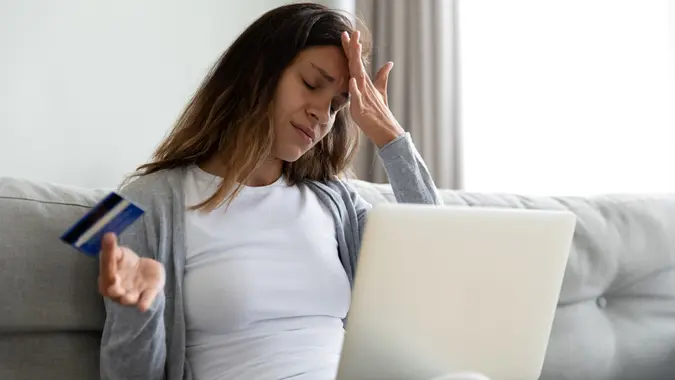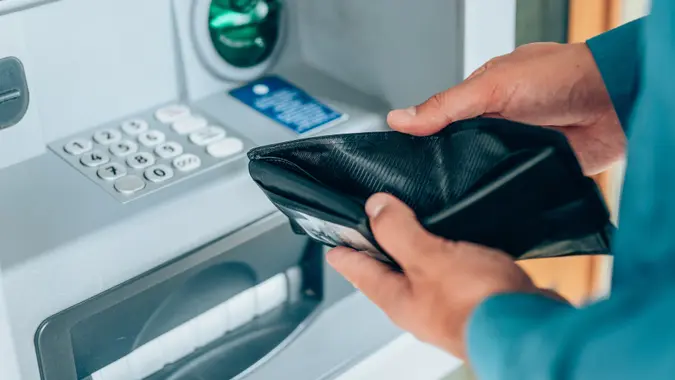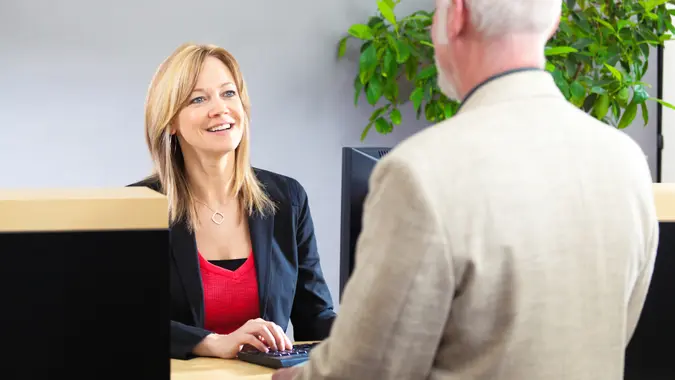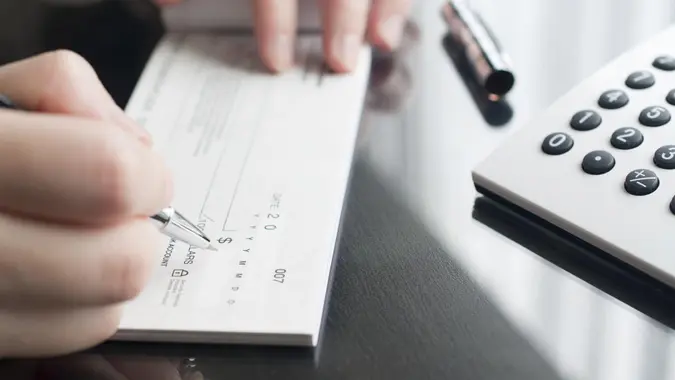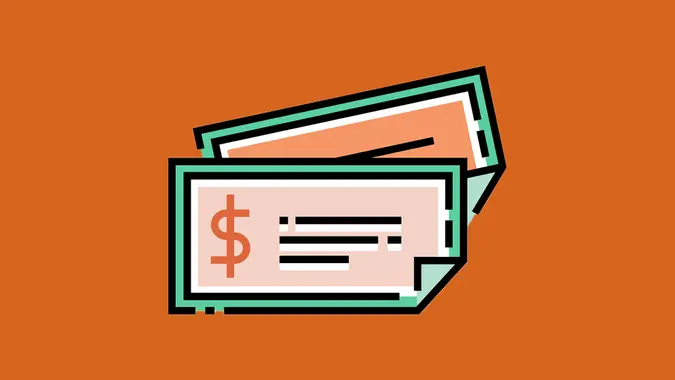Is It Safe to Write Checks With an Outdated Address?

Commitment to Our Readers
GOBankingRates' editorial team is committed to bringing you unbiased reviews and information. We use data-driven methodologies to evaluate financial products and services - our reviews and ratings are not influenced by advertisers. You can read more about our editorial guidelines and our products and services review methodology.

20 Years
Helping You Live Richer

Reviewed
by Experts

Trusted by
Millions of Readers
In today’s digital age, paper checks are less common than they once were, but they’re still around. If you’ve moved and found an old checkbook with your previous address, you may be wondering if you can still use it. Here’s what you need to know.
Can You Use Checks With an Old Address?
The short answer is yes, you can use checks with an old address. The validity of a check is not determined by the address printed on it. It depends on other crucial elements, such as the account number, routing number and the account holder’s signature. These components are key to the check’s functionality, not the address.
There may, however, be situations in which you don’t want to use a check that doesn’t have your current address printed on it.
Are Banks Required to Verify Your Address?
A bank may, but is not required to, verify the address on a check that is presented. If you are cashing a check from your own account in person at a branch, be prepared to explain if there is a discrepancy between the address on your account and the address on the check. The bank may hold the funds for a longer period of time than they normally would if they suspect the check may be fraudulent.
Situations Where You Can Use Checks With an Old Address
If you have a check with an old address on it, you probably won’t have an issue cashing it at your own bank, particularly if you are known by the tellers there. They can verify your account number using your debit card and/or your driver’s license or other government-issued ID.
If you are trying to cash a large check at your own bank, it may help you to have documentation of your previous address and your current address. This might include utility bills or other mail, or tax returns, showing both addresses.
When a check is deposited in an ATM or using mobile deposit, the address isn’t likely to be scrutinized, so it’s unlikely you would need to present documentation in these scenarios.
When You Shouldn’t Use Checks With an Old Address
There are times when you should avoid using a check with an old address. If you are writing a check for a large transaction, or if you are writing a check at your bank for a bank check or cashier’s check, it is safer to use a check that has your current address printed on it.
If you use a check with an old address to pay a bill such as a utility bill or make a payment to a business for a service, there could be some confusion in applying the payment to your account if the address on the check is different from the address on your account at the business. For this reason, it’s best not to use a check with an old address in these situations.
How To Update Your Address on Checks
The surest way to avoid any issues with outdated addresses on check is to order new checks with your current address on them. Ordering new checks is a straightforward process that can usually be completed online, in person or over the phone. Here’s a guide to ensure you get your new checks quickly and efficiently:
- Contact your bank or credit union: Start by reaching out to the financial institution where you have your checking account. Most banks and credit unions offer their own check ordering services. You can usually find information on check ordering on the bank’s website or mobile app.
- Use an online check printer: Alternatively, you can order checks through online check printing services. These companies often offer a wider variety of designs and might be more cost-effective. Your bank may direct you to an online check printer, or you can find one yourself.
- Gather necessary information: Before ordering, make sure you have your account number, the bank’s routing number and your personal information like name, current address and phone number. This information should all match the information on your bank account.
- Choose check style and quantity: Decide on the style of your checks and how many you need. It may seem more cost effective to order a lot of checks, but if you do most of your banking transactions online and may move again in the future, opt for a small number of checks.
- Review security features: Consider opting for checks with enhanced security features to protect against fraud, especially if you often write high-value checks.
- Confirm and place your order: Double-check all the details for accuracy and then place your order. Keep a record of the transaction for future reference.
- Wait for delivery: Delivery times can vary, so plan accordingly. Some financial institutions or services offer expedited shipping for an additional fee.
- Destroy old checks: If your old checks have outdated or incorrect information, it’s a good practice to destroy them to prevent any misuse or confusion.
Can You Correct the Address Manually?
It may be tempting to just cross out the old address on your check and write in the new one, but this is usually not a good idea. This will likely cause more scrutiny that just using a check with an outdated address.
Never attempt to use a check on which you have attempted to alter the account number or routing number.
Alternatives to Using Checks With an Old Address
If you only have checks with an outdated address and you don’t want to use them, you still have options. You can complete most transactions electronically, ether by using a debit card or by sending funds with Venmo, Zelle, or another electronic payment app.
You can also go into a branch of your bank and ask them to print blank checks for you. If you need a check for a large amount, you can request a bank check or cashier’s check.
What To Do if Your Old-Address Check Is Rejected
In the unlikely event that your check is rejected because of an old address, here are some steps to take.
- Contact the payee of the check and explain the situation.
- Ask how to cover the rejected check – they may require cash or a bank check.
- If the payee has deposited the check and it was rejected by their bank, there may be a fee which you should cover.
To avoid a similar issue in the future, order new checks with your current address on them, and destroy your outdated checks.
Final Tips for Using Checks Safely
Checks with an old address are typically valid as long as other essential details like the account number, routing number and signature are correct and current. It’s more a matter of personal preference than a banking requirement.
Whether the address on your checks is current or not, it’s important to track and record the checks that you write. Record checks in your check register as you write them and check them off as they are cashed. Add up all the outstanding check amounts and subtract this from your current balance so you’ll know how much money you actually have to spend.
Reducing your reliance on paper checks can help you keep better financial records and reduce risk of fraud. Automating regular transactions, like bill payments, and moving money electronically is faster and more efficient than paper checks.
FAQ
- Can I use checks with a crossed-out address?
- It's best not to cross out anything that is pre-printed on a check. If the address is incorrect, leave it as is and notify the payee that the address is old.
- How long can I keep using old checks?
- As long as the bank routing number and account number are correct, and the account is still open, you should be able to continue to use the checks. If your address has changed, you should consider ordering new checks to avoid confusion.
- Do businesses check addresses on personal checks?
- Most businesses do not, but if you are making a payment on an account, there may be confusion if the address on the check is different from the address on the account.
Editor's note: This article was produced via automated technology and then fine-tuned and verified for accuracy by a member of GOBankingRates' editorial team.
 Written by
Written by  Edited by
Edited by 



